Exploring Engineering Students’ Perceptions of Diversity and Inclusion in a Southern Public University: A Case Study
Abstract
1. Introduction
2. Materials and Methods
2.1. Textbook Evaluation
2.1.1. Samples
2.1.2. Sample Analysis
2.2. In-Person Interviews
2.2.1. Participants
2.2.2. Materials and Procedures
2.2.3. Analytical Process
2.3. Student Surveys
2.3.1. Participants
2.3.2. Materials and Procedures
2.3.3. Analytical Process
3. Results and Discussion
3.1. Civil Engineering Textbook Evaluation Results
3.2. Students’ Perception Survey Results
3.2.1. Demographic Information of Participant
3.2.2. Engineering Student Perceptions of Diversity
- General Perception about College and University
- Diversity in Textbooks and Curriculum
3.2.3. Student Organization and Involvement
3.2.4. Diversity in Engineering Workplace
3.3. Students’ Interview Results
3.3.1. Interest Driven Engineering Pursuit
3.3.2. Why Diversity and Inclusion Are Important for Engineering?
3.3.3. Suggestions for Improving Diversity and Inclusion in Engineering
4. Conclusions
4.1. Textbook
4.2. Students’ Perceptions of Diversity
4.2.1. General Perception
4.2.2. Diversity in Textbooks and Curriculum
4.3. Students Organization
4.4. Workforce
Author Contributions
Funding
Institutional Review Board Statement
Informed Consent Statement
Data Availability Statement
Acknowledgments
Conflicts of Interest
Appendix A
| Items | Girl/Woman | Boy/Man | Non-Binary | Total |
|---|---|---|---|---|
| Middle Eastern | ||||
| Asian/Pacific Islander | ||||
| Black/African | ||||
| Latinx | ||||
| Native American | ||||
| White/Caucasian | ||||
| Racially Ambiguous | ||||
| Multiracial | ||||
| People with Disabilities | ||||
| Animals | ||||
| Total |
| Statements | Very Satisfied (+2) | Satisfied (+1) | Unclear(−1) | Not Satisfied (−2) | |
|---|---|---|---|---|---|
| Diversity of Characters | 1. The textbook features visually diverse characters, and the characters of color do not all look alike. | ||||
| 2. There are references to different ethnic and cultural traditions, languages, religions, names, and clothing. | |||||
| 3. Diverse ethnicities and nationalities are portrayed—not all Asian families are Chinese, not all Latinx families are Mexican, etc. | |||||
| 4. Diverse family structures (i.e., single parents, adopted or foster children, same-sex parents, other relatives living with the family, etc.) are represented. | |||||
| 5. Characters with disabilities are represented. | |||||
| 6. Characters of color are main characters and not just sidekicks. | |||||
| 7. If there is conflict in the storyline, the characters of color are not mostly considered the problem. | |||||
| Accurate Portrayals | 8. Characters of color are not assumed to have low family wealth, low educational attainment, and/or low income. | ||||
| 9. Gender is not central to the storyline. Female characters are in a variety of roles that could also be filled by a male character. | |||||
| 10. Social situations and problems are not seen as individual problems but are situated within a societal context. | |||||
| 11. Characters of diverse cultural backgrounds are not represented stereotypically or presented as foreign or exotic. | |||||
| 12. Problems faced by people of color or females are not resolved through the benevolent intervention of a white person or male. | |||||
| 13. Diverse characters are rooted in their own cultures and are not ambiguous | |||||
| Total | |||||
| Total Representation Score | |||||
| Statements | Very Satisfied (+2) | Satisfied (+1) | Unclear (−1) | Not Satisfie d (−2) | |
|---|---|---|---|---|---|
| Decolonization/ Power and Privilege | 1. Textbook highlights non-dominant populations and their strengths and assets, so that students of diverse race, class, gender, ability, and sexual orientation can relate and participate fully. | ||||
| 2. Textbook communicates an asset-based perspective by representing people of diverse races, classes, genders, abilities, and sexual orientations through their strengths, talents, and knowledge rather than their perceived flaws or deficiencies. | |||||
| 3. Textbook does not communicate negativity or hostility toward people of marginalized backgrounds through verbal or nonverbal insults, slights, or snubs. | |||||
| 4. Textbook and instructional activities promote or provoke critical questions about the societal status quo. They present alternative points of view as equally worth considering. | |||||
| 5. Textbook recognizes the validity and integrity of knowledge systems based in communities of color, collectivist cultures, matriarchal societies, and non-Christian religions. | |||||
| Centering Multiple Perspectives | 6. Textbook recognizes the validity and integrity of knowledge systems based in communities of color, collectivist cultures, matriarchal societies, and non-Christian religions. | ||||
| 7. Textbook presents different points of view on the same event or experience, especially points of view from marginalized people and communities. | |||||
| Connect Learning to Real Life & Action | 8. Textbook provides avenues for students to connect learning to social, political, or environmental concerns that affect them and their lives and contribute to change. | ||||
| 9. Textbook encourages students to take actions that combat inequity or promote equity within the school or local community. | |||||
| Total | |||||
| Total Representation Score | |||||
| Questions | Options |
|---|---|
| (A) Strongly Agree; (B) Agree; (C) Neutral; (D) Disagree; (E) Strongly Disagree |
|
|
| (A) Strongly Agree; (B) Agree; (C) Neutral; (D) Disagree; (E) Strongly Disagree |
|
|
| Choose from 1 (lowest score) to 10 (highest score). |
| (A) Yes; (B) No; (C) Maybe |
|
|
|
|
| |
| |
| |
| |
| |
| |
|
|
|
|
|
|
| |
| |
| |
| |
| |
| |
| |
| |
| |
| |
|
|
|
|
| Open answers. |
| Questions | Options |
|---|---|
| (A) Yes. (B) No. |
| Open answers. |
|
|
| (A) Very good; (B) Good; (C) Neutral; (D) Not Good; (E) Poor |
| (A) Very good; (B) Good; (C) Neutral; (D) Not Good; (E) Poor |
| (a) Yes. (B) No. (C) Maybe. |
|
|
|
|
|
|
| |
| |
| |
|
| Questions | Options |
|---|---|
| (A) Yes. (B) No. |
| (A) Less than 50 people; (B) 50 to 100 people; (C) More than 100 people; (D) Not sure. |
| (A) Local or regional; (B) Family-owned; (C) Domestic; (D) International; (E) Profit; (F) Non-profit |
|
|
|
|
|
|
|
|
| |
| |
| |
|
| S/N | Mann–Whitney U Test | Ethnicity | Gender | ||
|---|---|---|---|---|---|
| Test Statistic (U) | p-Value | Test Statistic (U) | p-Value | ||
| 1 | How do you agree or disagree with the statement “I feel a sense of belonging to the College of Engineering at the University of South Alabama”? | 368.0 | 0.0 | 503.5 | 0.458 |
| 2 | As an engineering student, when you hear about “diversity in engineering”, what is your feeling? | 816.0 | 0.890 | 677.5 | 0.052 |
| 3 | How do you agree with the statement “Diversity can provide benefits to engineering”? | 432.0 | 0.815 | 608.5 | 0.548 |
| 4 | After reading the definition and according to your own experience, how important do you think diversity in engineering is? | 706.5 | 0.110 | 765.5 | 0.005 |
| 5 | If you were to give a score about your overall impression about the status of diversity in the University of South Alabama, which score would you give? | 391.0 | 0.015 | 641.5 | 0.310 |
| 6 | The University of South Alabama has the office of Diversity, Equity, and Inclusion. How much do you know about its function and role? | 625.0 | 0.654 | 497.5 | 0.428 |
| 7 | How do you feel about the relevancy of the following description to “diversity in engineering”? (Engineers are a diverse group of people regardless of gender, age, ethnicity, religion, backgrounds, etc.) | 652.5 | 0.413 | 597.5 | 0.637 |
| 8 | How do you feel about the relevancy of the following description to “diversity in engineering”? (Engineers get along well with colleagues.) | 559.5 | 0.712 | 554.5 | 0.935 |
| 9 | How do you feel about the relevancy of the following description to “diversity in engineering”? (Engineers work with various clients.) | 573.0 | 0.837 | 578.5 | 0.805 |
| 10 | How do you feel about the relevancy of the following description to “diversity in engineering”? (Engineers provide solutions that satisfy the constraints of cost, performance, environment and society.) | 596.0 | 0.915 | 648.0 | 0.208 |
| 11 | How do you feel about the relevancy of the following description to “diversity in engineering”? (Engineers have equal opportunities to get promoted and receive salary increases.) | 518.5 | 0.368 | 489.0 | 0.339 |
| 12 | How do you feel about the relevancy of the following description to “diversity in engineering”? (Engineers join organizations such as the Society of Women Engineers and the National Society of Black Engineers.) | 324.0 | 0.076 | 698.0 | 0.074 |
| 13 | Have you recognized any engineering courses that have components of diversity? Examples of components: have a diversity statement in syllabus, learning objective that includes diversity, instructor talks about diversity directly or indirectly. | 364.5 | 0.004 | 490.0 | 0.362 |
| 14 | You have taken many engineering courses. Generally speaking, how much are components of diversity a part of engineering textbooks used in your courses? | 462.0 | 0.109 | 636.0 | 0.330 |
| 15 | How do you view the importance of the following practices that can promote diversity in an engineering course? (There is a clear statement about diversity and inclusion in the syllabus.) | 768.5 | 0.029 | 728.0 | 0.039 |
| 16 | How do you view the importance of the following practices that can promote diversity in an engineering course? (The textbook contains more diverse examples (e.g., using an example of an engineer who is part of an underrepresented group).) | 834.0 | 0.003 | 765.5 | 0.011 |
| 17 | How do you view the importance of the following practices that can promote diversity in an engineering course? (Instructors remember your name, personally connect with you, and get to know you well.) | 680.0 | 0.186 | 561.0 | 1.000 |
| 18 | How do you view the importance of the following practices that can promote diversity in an engineering course? (Instructors care about everyone’s learning experience and academic performance.) | 601.5 | 0.836 | 600.0 | 0.530 |
| 19 | How do you view the importance of the following practices that can promote diversity in an engineering course? (Instructors have a clear and transparent grading policy for everyone.) | 555.5 | 0.572 | 591.5 | 0.588 |
| 20 | How do you view the importance of the following practices that can promote diversity in an engineering course? (Instructors use some examples related to diversity and inclusion to help students learn technical content.) | 683.5 | 0.245 | 743.5 | 0.023 |
| 21 | How do you view the importance of the following practices that can promote diversity in an engineering course? (Instructors design an assignment related to diversity and inclusion.) | 771.5 | 0.027 | 802.0 | 0.003 |
| 22 | How do you view the importance of the following practices that can promote diversity in an engineering course? (Instructors embrace diversity and invite guest technical speakers who have diverse backgrounds.) | 772.0 | 0.020 | 785.5 | 0.004 |
| 23 | How do you view the importance of the following practices that can promote diversity in an engineering course? [(nstructors lead field trips that can broaden students’ horizons in not only technical knowledge but also diversity and inclusion.) | 812.5 | 0.005 | 708.5 | 0.060 |
| 24 | How do you view the importance of the following practices that can promote diversity in an engineering course? (Instructors inspire all students to engage in active learning.) | 531.5 | 0.373 | 603.0 | 0.499 |
| 25 | Have you ever been discriminated against or encountered an uncomfortable learning environment as an engineering student because of your race, gender, or any other reason? | 787.0 | 0.007 | 806.5 | 0.001 |
| 26 | If you encountered an uncomfortable learning environment because of your race, gender, or for other reasons that are not fair to you, what would you do? (Check all that apply) | 3396.0 | 0.829 | 3396.0 | 0.829 |
| 27 | How do you feel about the representation of people of color in your student organization? | 214.0 | 0.018 | 288.5 | 0.515 |
| 28 | How do you feel about the representation of women in your advised student organization? | 232.5 | 0.021 | 279.5 | 0.330 |
| 29 | In your student organization, club, or society, do you have a clear policy or statement that promotes diversity? | 281.5 | 0.538 | 313.5 | 0.360 |
| 30 | How do you feel about the diversity activities that the University of South Alabama has conducted? | 433.0 | 0.053 | 497.5 | 0.418 |
| 31 | What activities would you recommend to promote diversity in engineering? (Increasing the number of members who represent minorities in the engineering student organizations.) | 732.0 | 0.076 | 811.0 | 0.002 |
| 32 | What activities would you recommend to promote diversity in engineering? (Increasing the number of engineering scholarships designated for minorities.) | 831.0 | 0.010 | 841.5 | 0.002 |
| 33 | What activities would you recommend to promote diversity in engineering? (Having a designated funding resource for minority engineering students which can be applied to enhance learning and professional development.) | 801.5 | 0.010 | 786.0 | 0.005 |
| 34 | What activities would you recommend to promote diversity in engineering? (1 vs. 1 friend program that enhances interaction between engineering students.) | 740.5 | 0.081 | 734.5 | 0.039 |
| 35 | If you have worked for an engineering company, what is your impression about the company’s diversity in the workplace? | 114.0 | 0.237 | 100.0 | 0.852 |
| 36 | Have you ever been discriminated against or encountered an uncomfortable working environment because of your race, gender, or any other reason? | 350.5 | 0.010 | 356.0 | 0.003 |
| 37 | Do you believe that some groups of people have fewer opportunities to succeed in engineering careers? | 1299.0 | 0.001 | 763.0 | 0.007 |
| 38 | How much do you agree with the following statements? (Diversity, equity, and inclusion are necessary to build a stronger, more unified profession.) | 739.5 | 0.050 | 734.5 | 0.021 |
| 39 | How much do you agree with the following statements? (If I seek employment, I prefer to work for a company that has a clear policy of diversity, equity, and inclusion.) | 760.0 | 0.033 | 747.0 | 0.019 |
| 40 | How much do you agree with the following statements? (It is not my responsibility to promote diversity, equity, and inclusion.) | 644.5 | 0.491 | 497.5 | 0.427 |
| 41 | How much do you agree with the following statements? (If the company I work for emphasizes diversity, equity, and inclusion, I feel I would be more fairly treated regardless of who I am.) | 749.0 | 0.046 | 768.0 | 0.009 |
References
- National Academy of Engineering (NAE). Diversity in Engineering: Managing the Workforce of the Future; The National Academies Press: Washington, DC, USA, 2002. [Google Scholar] [CrossRef]
- Leydens, J.A.; Lucena, J.C. Making the invisible visible: Integrating engineering-for-social-justice criteria in humanities and social science courses. In Proceedings of the ASEE’s 123rd Annual Conference and Exposition, New Orleans, LA, USA, 26 June–28 August 2016. [Google Scholar]
- Pearson, Y.E.; Simmons, D.R. Diversity and inclusion in civil and environment engineering. J. Prof. Issues Educ. Pract. 2018, 144, 02018001. [Google Scholar] [CrossRef]
- Manesh, S.N.; Choi, J.O.; Shrestha, P. Critical literature review on the diversity and inclusion of women and ethnic minorities in construction and civil engineering industry and education. In Proceedings of the Construction Research Congress, Tempe, AZ, USA, 8–10 March 2020. [Google Scholar]
- True-Funk, A.; Poleacovschi, C.; Jones-Johnson, G.; Feinstein, S.; Smith, K.; Luster-Teasley, K. Intersectional Engineers: Diversity of Gender and Race Microaggressions and Their Effects in Engineering Education. J. Manag. Eng. 2021, 37, 04021002. [Google Scholar] [CrossRef]
- Armanios, D.E.; Christian, S.J.; Rooney, A.F.; McElwee, M.L.; Moore, J.D.; Nock, D.; Samaras, C.; Wang, G.J. Diversity, Equity, and inclusion in civil and environmental engineering education: Social justice in a changing climate. In Proceedings of the ASEE Annual Conference and Exposition, Virtual, 26 July 2021. [Google Scholar]
- Hickey, P.J.; Cui, Q. Gender diversity in US construction industry leaders. J. Manag. Eng. 2020, 36, 04020069. [Google Scholar] [CrossRef]
- Casper, A.M.; Atadero, R.A.; Hedayati-Mehdiabadi, A.; Baker, D.W. Linking Engineering Students’ Professional Identity Development to Diversity and Working Inclusively in Technical Courses. J. Civ. Eng. Educ. 2019, 147, 04021012. [Google Scholar] [CrossRef]
- Phillips, K.W. How diversity makes us smarter: Being around people who are different from us makes us more creative, more diligent and harder-working. Sci. Am. 2014, 311, 43–47. [Google Scholar]
- Matthews, K. Why is Diversity in Engineering a Major Opportunity? ASME. Available online: https://www.asme.org/topics-resources/content/why-is-diversity-in-engineering-a-major-opportunity (accessed on 17 November 2023).
- Barnett, R.M. Leading with meaning: Why diversity, equity and inclusion matters in us higher education. Perspect. Educ. 2020, 38, 20–35. [Google Scholar] [CrossRef]
- Coughlin, T. How You Can Help Improve Diversity and Inclusion in Engineering. IEEE. Available online: https://insight.ieeeusa.org/articles/how-you-can-help-improve-diversity-and-inclusion-in-engineering/ (accessed on 18 November 2023).
- Lockheed Martin Engineering Management Program. Equity, Inclusion and Diversity in Engineering: Why They Matter. University of Colorado Boulder. Available online: https://www.colorado.edu/emp/2021/01/22/equity-inclusion-and-diversity-engineering-why-they-matter (accessed on 17 November 2023).
- Leland. Breaking Barriers: Inspiring Stories of Underrepresented Individuals Succeeding in Software Engineering. Available online: https://www.joinleland.com/library/a/breaking-barriers-inspiring-stories-of-underrepresented-individuals-succeeding-in-software-engineering (accessed on 17 November 2023).
- Blume, A.W.; Lovato, L.V.; Thyken, B.N.; Denny, N. The relationship of microaggressions with alcohol use and anxiety among ethnic minority college students in a historically White institution. Cult. Divers. Ethn. Minor Psychol. 2012, 18, 45–54. [Google Scholar] [CrossRef] [PubMed]
- Boysen, G.A. Teacher and Student Perceptions of Microaggressions in College Classrooms. Coll. Teach. 2012, 60, 122–129. [Google Scholar] [CrossRef]
- Marshall, A.; Pack, A.D.; Owusu, S.A.; Hultman, R.; Drake, D.; Rutaganira, F.U.; Namwanje, M.; Evans, C.S.; Garza-Lopez, E.; Lewis, S.C.; et al. Responding and navigating racialized microaggressions in STEM. Pathog. Dis. 2021, 79, ftab027. [Google Scholar] [CrossRef]
- Karakhan, A.A.; Gambatese, J.A.; Simmons, D.R.; Al-Bayati, A.J. Identifying Pertinent Indicators for Assessing and Fostering Diversity, Equity, and Inclusion of the Construction Workforce. J. Manag. Eng. 2021, 37, 04020114. [Google Scholar] [CrossRef]
- Bryan-Gooden, J.; Hester, M.; Peoples, L.Q. Culturally Responsive Curriculum Scorecard; Metropolitan Center for Research on Equity and the Transformation of Schools, New York University: New York, NY, USA, 2019. [Google Scholar]
- Hartman, H.; Forin, T.; Sukumaran, B.; Farrell, S.; Bhavsar, P.; Jahan, K.; Dusseau, R.; Bruckerhoff, T.; Cole, P.; Lezotte, S.; et al. Strategies for improving diversity and inclusion in an engineering department. J. Prof. Issues Eng. Educ. Pract. 2018, 145, 04018016. [Google Scholar] [CrossRef]
- Rainey, K.; Dancy, M.; Mickelson, R.; Stearns, E.; Moller, S. Race and gender differences in how sense of belonging influences decisions to major in STEM. Int. J. STEM Educ. 2018, 5, 10. [Google Scholar] [CrossRef] [PubMed]
- Pearson, N.; Godwin, A.; Kirn, A. The effect of diversity on feelings of belongingness for new engineering students. In Proceedings of the 2018 IEEE Frontiers in Education Conference (FIE), San Jose, CA, USA, 3–6 October 2018. [Google Scholar] [CrossRef]
- Fan, X.; Luchok, K.; Dozier, J. College students’ satisfaction and sense of belonging: Differences between underrepresented groups and the majority groups. SN Soc. Sci. 2021, 1, 22. [Google Scholar] [CrossRef]
- Beatty Moody, D.L.; Waldstein, S.R.; Leibel, D.K.; Hoggard, L.S.; Gee, G.C.; Ashe, J.J.; Brondolo, E.; Al-Najjar, E.; Evans, M.K.; Zonderman, A.B. Race and other sociodemographic categories are differentially linked to multiple dimensions of interpersonal-level discrimination: Implications for intersectional, health research. PLoS ONE 2021, 16, e0251174. [Google Scholar] [CrossRef] [PubMed]
- Boyd-Sinkler, K.; Hermundstad, A.L.; Artiles, M.S.; Phillips, C.M.L.; Lutz, B.D.; Lee, W.C. Student Conceptualizations about Diversity: “How would you describe the diversity in engineering at your institution?”. In Proceedings of the CoNECD 2018—Collaborative Network for Engineering and Computing Diversity Conference, Crystal City, VA, USA, 29 April–2 May 2018. [Google Scholar]
- Odum, M.; Meaney, K.S.; Knudson, D.V. Active learning classroom design and student engagement: An exploratory study. J. Learn. Spaces 2021, 10, 27–42. [Google Scholar]
- Atuahene, F. Predicting the Academic Success of Minority Male Students in a Public 4-Year Institution in the USA. J. Afr. Am. Stud. 2021, 25, 29–51. [Google Scholar] [CrossRef]
- Wilson, K.C. Grading improves transparency and quality. Chest 2008, 134, 1107. [Google Scholar] [CrossRef] [PubMed]
- Feldman, J. Building more Inclusive Communities with Grading for Equity. Available online: www.nais.org/magazine/independent-school/summer-2019/grading-for-equity/ (accessed on 20 November 2023).
- Moreu, G.; Isenberg, N.; Brauer, M. How to Promote Diversity and Inclusion in Educational Settings: Behavior Change, Climate Surveys, and Effective Pro-Diversity Initiatives. In Frontiers in Education; Frontiers Media SA: Lausanne, Switzerland, 2021; Volume 6. [Google Scholar] [CrossRef]
- Salehi, S.; Ballen, C.J.; Trujillo, G.; Wieman, C. Inclusive Instructional Practices: Course Design, Implementation, and Discourse. In Frontiers in Education; Frontiers Media SA: Lausanne, Switzerland, 2021; Volume 6. [Google Scholar] [CrossRef]
- Peixoto, A.; Gonzalez, C.S.G.; Strachan, R.; Plaza, P.; De Los Angeles Martinez, M.; Blazquez, M.; Castro, M. Diversity and inclusion in engineering education: Looking through the gender question. In Proceedings of the IEEE Global Engineering Education Conference, EDUCON, Santa Cruz de Tenerife, Spain, 17–20 April 2018. [Google Scholar] [CrossRef]
- Hughes, C.; Babbitt, L.G.; Krendl, A.C. Culture impacts the neural response to perceiving outgroups among black and white faces. Front. Hum. Neurosci. 2019, 13, 143. [Google Scholar] [CrossRef]
- Kricorian, K.; Seu, M.; Lopez, D.; Ureta, E.; Equils, O. Factors influencing participation of underrepresented students in STEM fields: Matched mentors and mindsets. Int. J. STEM Educ. 2020, 7, 16. [Google Scholar] [CrossRef]
- Ambikairajah, E.; Atakaramians, S.; Seneviratne, A. Teaching Engineering Students Equity, Diversity and Inclusion (EDI). In Proceedings of the IEEE International Conference on Teaching, Assessment and Learning for Engineering, Hung Hom, Hong Kong, 4–7 December 2022. [Google Scholar]
- Nel, M. Inclusive Education Working Towards a Humane Society: A Perspective on Reality. In Interdisciplinary Perspectives on Special and Inclusive Education in a Volatile, Uncertain, Complex & Ambiguous (Vuca) World; Emerald Publishing Limited: Bingley, UK, 2023. [Google Scholar] [CrossRef]
- Palid, O.; Cashdollar, S.; Deangelo, S.; Chu, C.; Bates, M. Inclusion in practice: A systematic review of diversity-focused STEM programming in the United States. Int. J. STEM Educ. 2023, 10, 2. [Google Scholar] [CrossRef]
- Kiradoo, G. Diversity, Equity, and Inclusion in the Workplace: Strategies for Achieving and Sustaining a Diverse Workforce. Adv. Res. Soc. Sci. Manag. 2022, 1, 139–151. [Google Scholar]

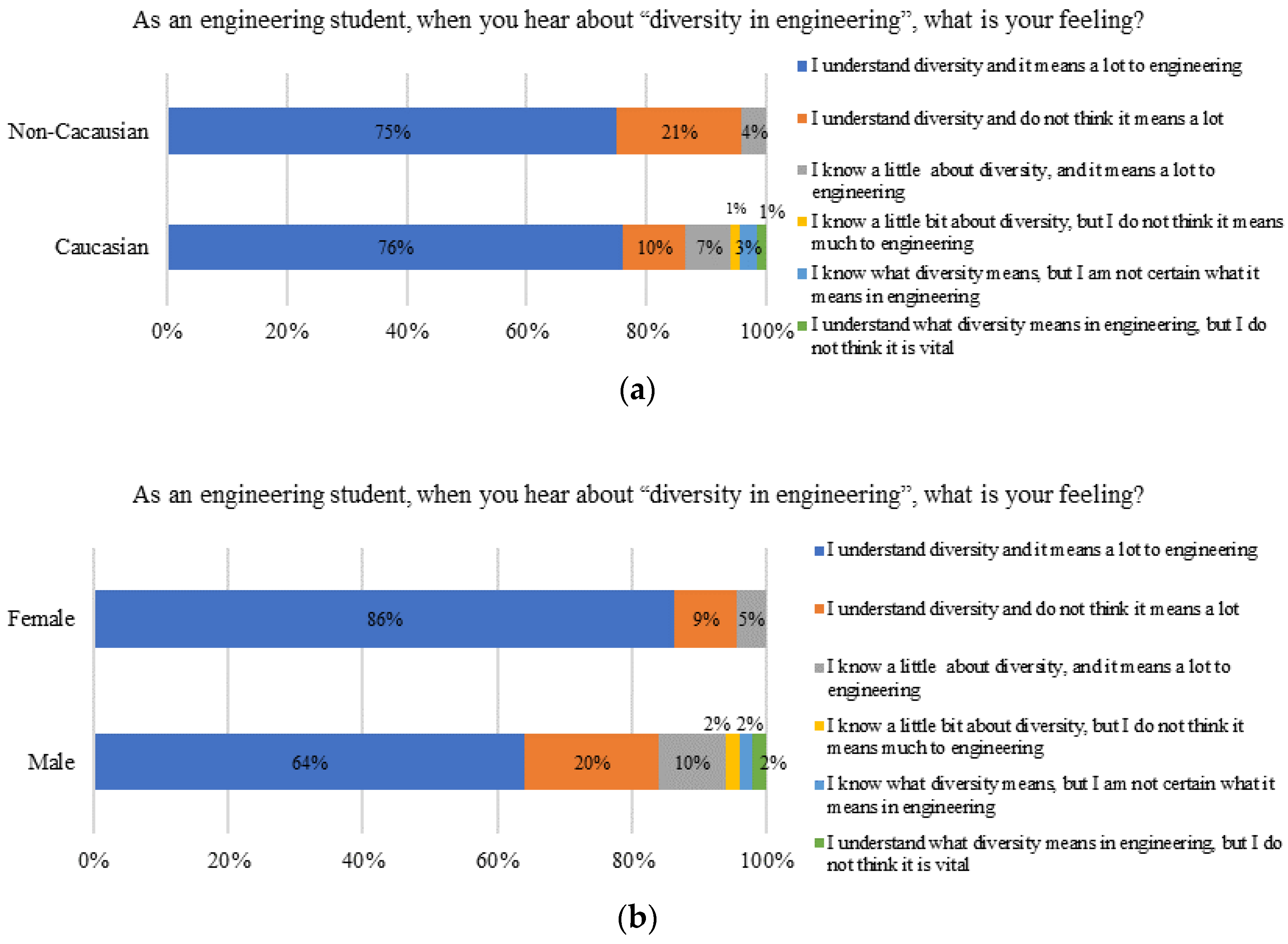


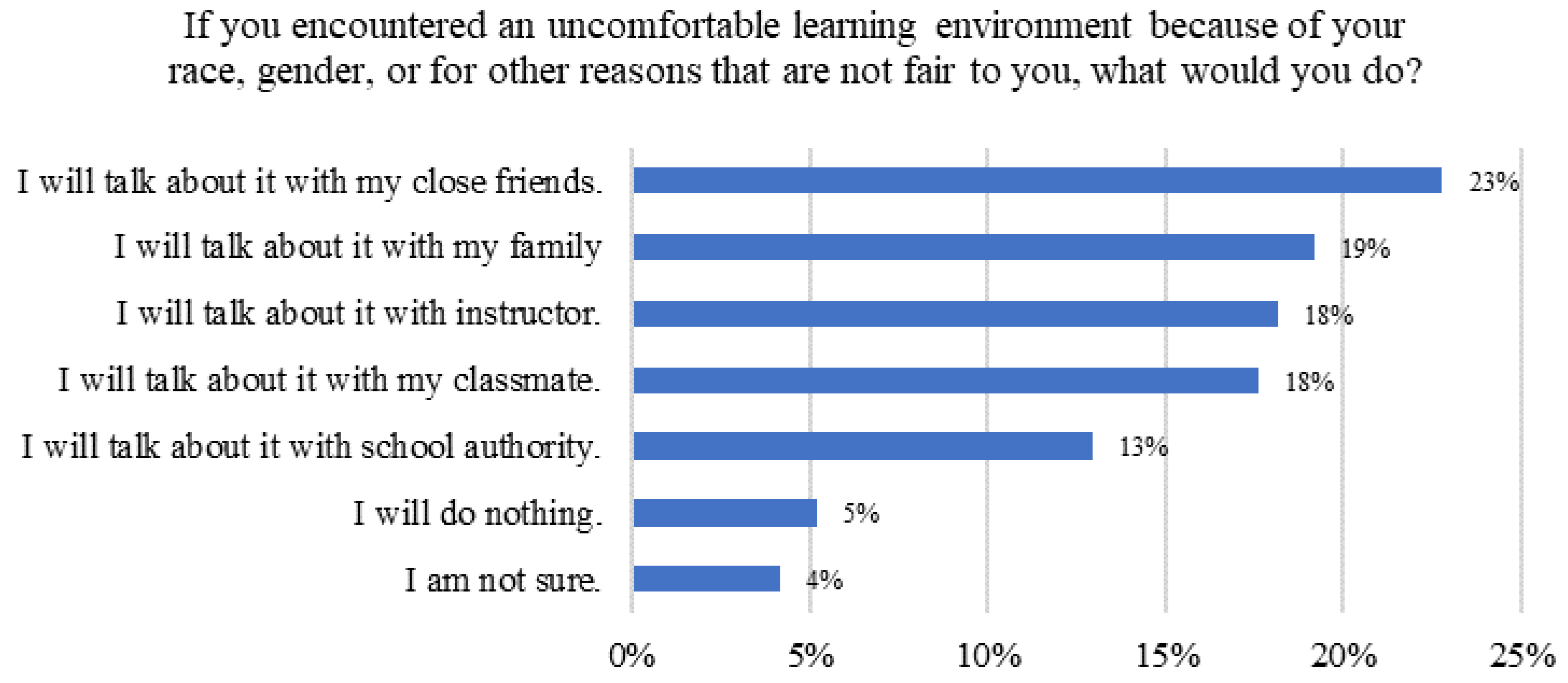





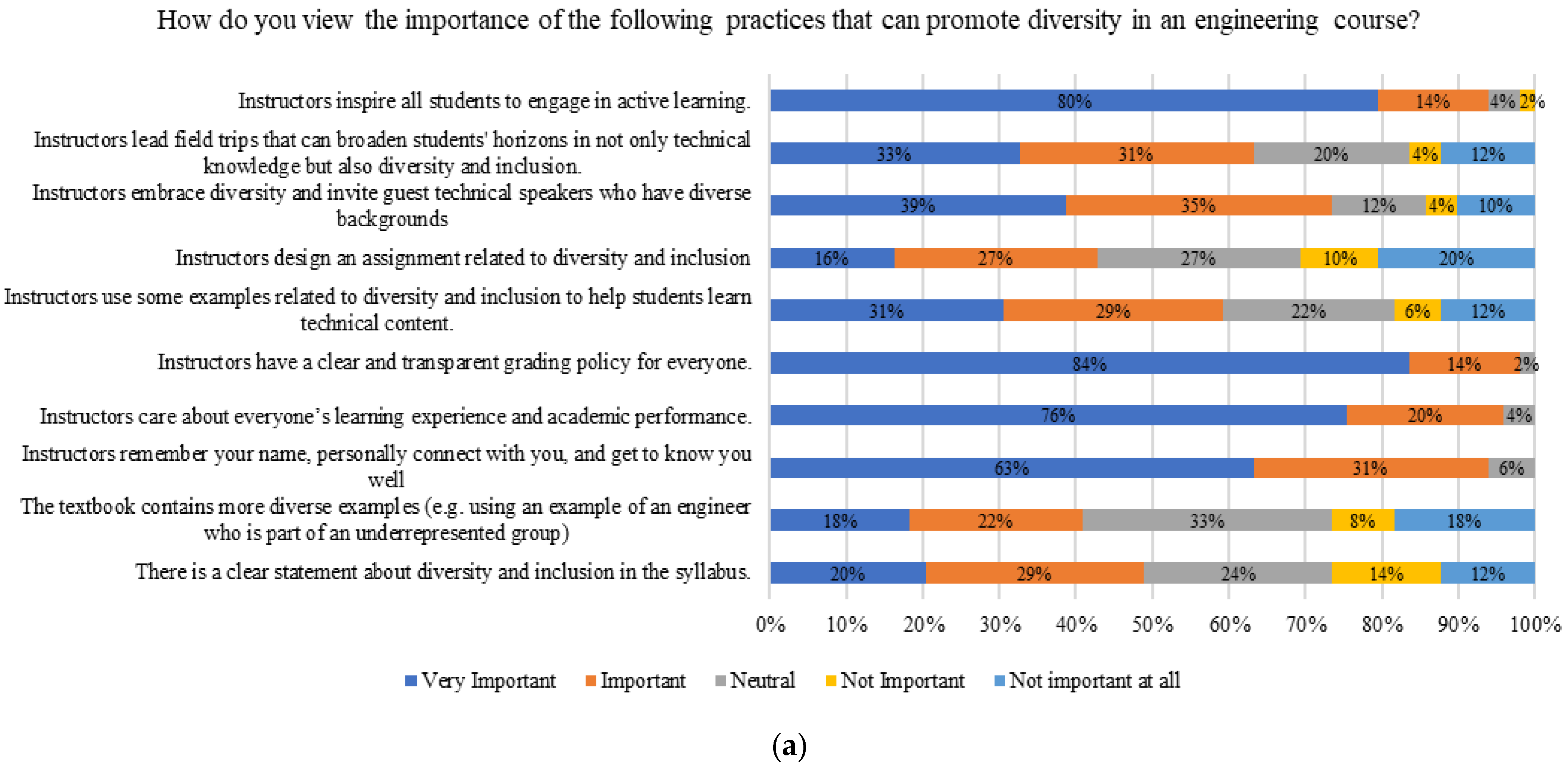

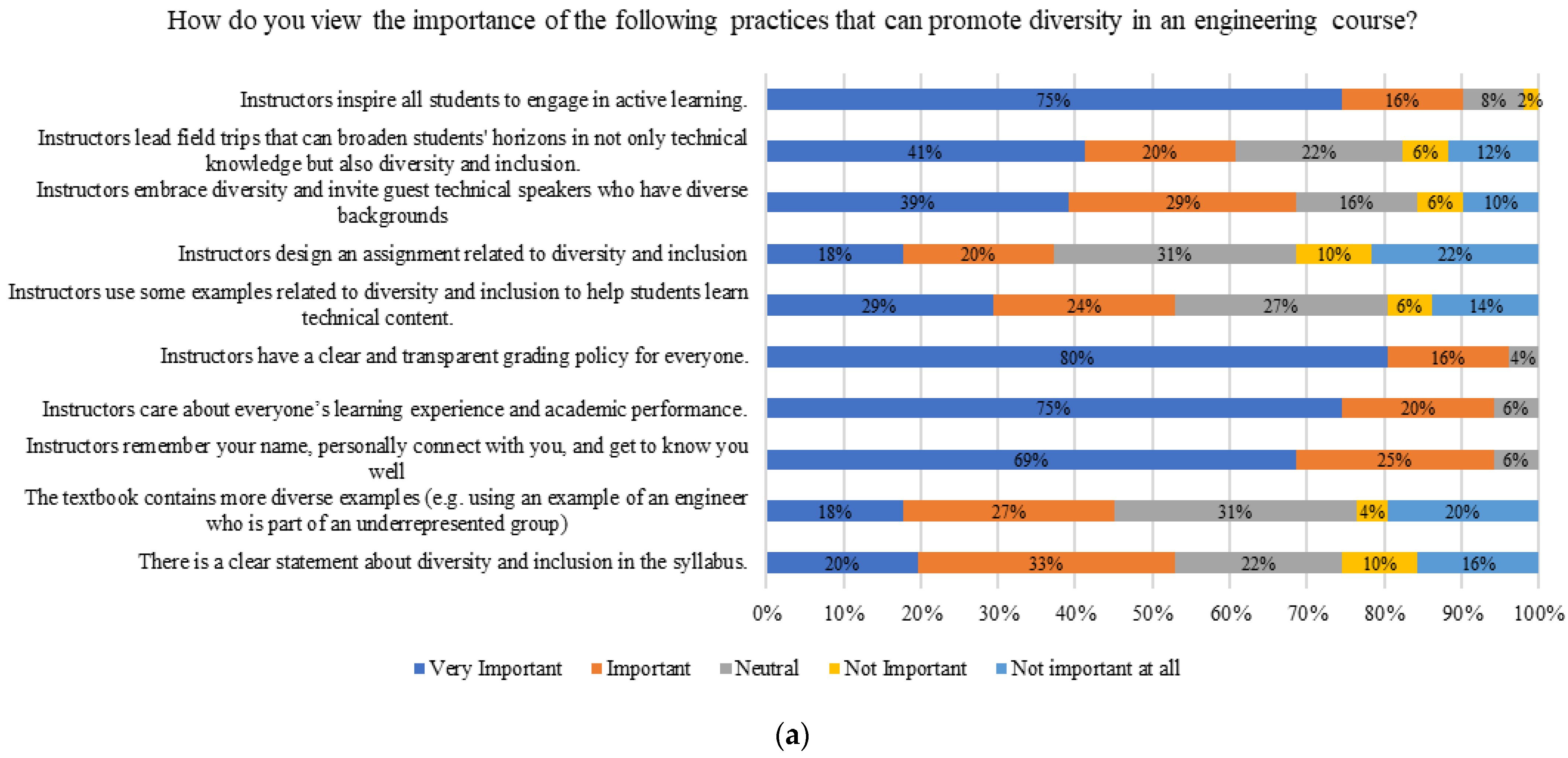











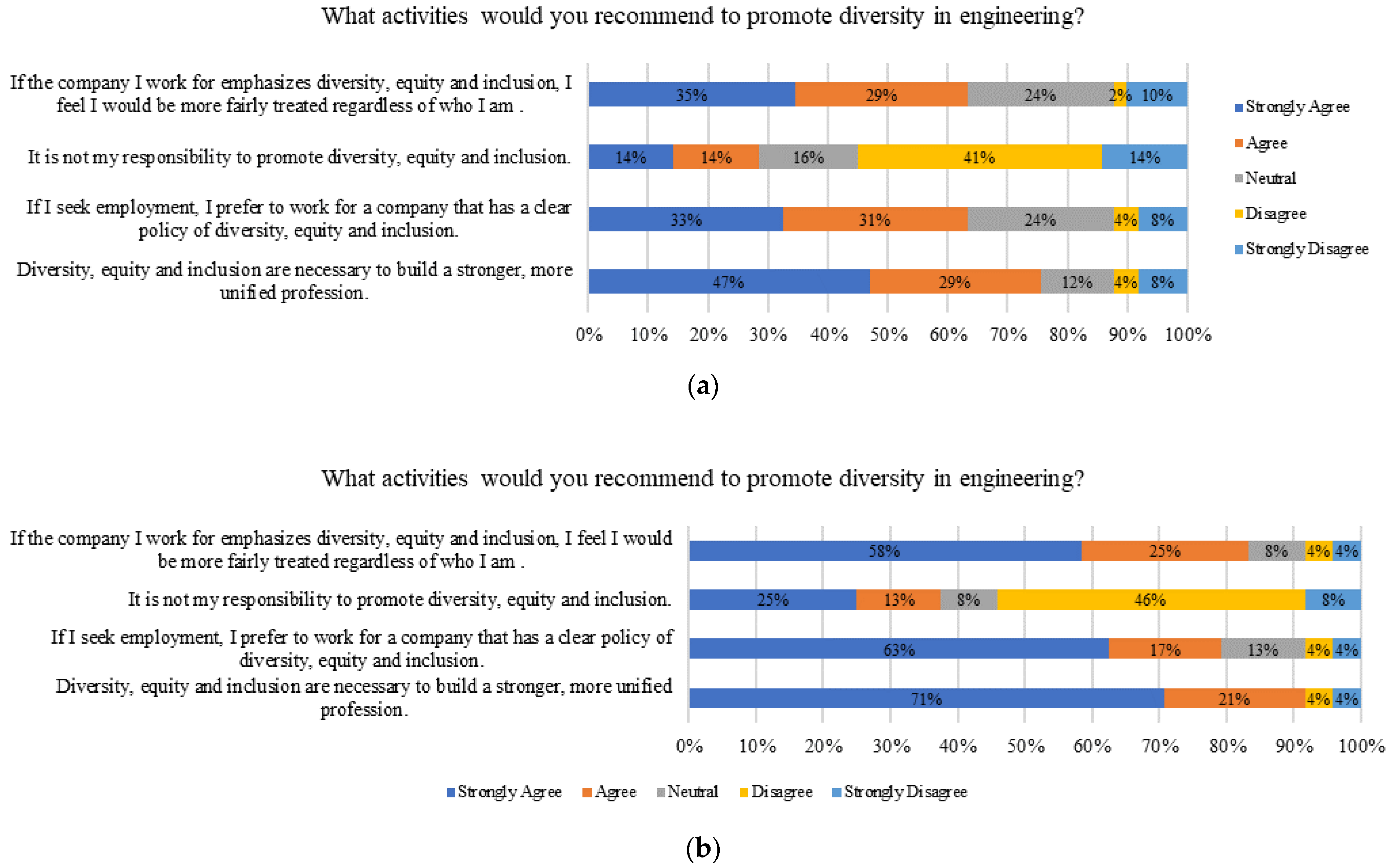


| Textbook Number | Diversity of Characters Tally | Diversity of Authors Tally | Representation | Social Justice | Total |
|---|---|---|---|---|---|
| 1 | 81 | 2 | −8 | 0 | −8 |
| 2 | 4 | 4 | 5 | 0 | 5 |
| 3 | 0 | 5 | 2 | −4 | −2 |
| Average | 28.3 | 3.7 | −0.3 | −1.3 | −1.7 |
| Representation Category | Culturally Destructive (−26 to −11); Culturally Insufficient (−10 to 0); Emerging Awareness (1 to 11); Culturally Aware (12 to 19); Culturally Responsive (20 to 26) | ||||
| Social Justice Category | Culturally Destructive (−16 to −7); Culturally Insufficient (−6 to 0); Emerging Awareness (1 to 7); Culturally Aware (8 to 12); Culturally Responsive (13 to 16) | ||||
| Item | Variables | No. | Percentage |
|---|---|---|---|
| Major | Electrical Engineering | 2 | 2.7% |
| Chemical and Biomolecular Engineering | 3 | 4.1% | |
| Mechanical Engineering | 27 | 37.0% | |
| Civil, Coastal and Environmental Engineering | 41 | 56.2% | |
| Gender | Male | 51 | 69.9% |
| Female | 22 | 30.1% | |
| Age | 20–24 | 50 | 69.4% |
| 25–29 | 13 | 18.1% | |
| 30–34 | 6 | 8.3% | |
| >40 | 3 | 4.2% | |
| Ethnicity | Caucasian | 49 | 67.1% |
| African-American | 7 | 9.6% | |
| Latino or Hispanic | 2 | 2.7% | |
| Asian | 5 | 6.8% | |
| Native American | 1 | 1.4% | |
| Two or More | 8 | 11.0% | |
| Other/Unknown | 1 | 1.4% | |
| Marriage Status | Single | 63 | 40.6% |
| Married | 91 | 58.7% | |
| Prefer not to say | 1 | 0.6% | |
| School Level | Freshman | 6 | 8.2% |
| Sophomore | 11 | 15.1% | |
| Junior | 30 | 41.1% | |
| Senior | 21 | 28.8% | |
| Graduate Student | 5 | 6.8% | |
| Political View | Very liberal | 8 | 11.0% |
| Slightly liberal | 15 | 20.5% | |
| Slightly conservative | 22 | 30.1% | |
| Very conservative | 13 | 17.8% | |
| Prefer not to say | 15 | 20.5% |
Disclaimer/Publisher’s Note: The statements, opinions and data contained in all publications are solely those of the individual author(s) and contributor(s) and not of MDPI and/or the editor(s). MDPI and/or the editor(s) disclaim responsibility for any injury to people or property resulting from any ideas, methods, instructions or products referred to in the content. |
© 2024 by the authors. Licensee MDPI, Basel, Switzerland. This article is an open access article distributed under the terms and conditions of the Creative Commons Attribution (CC BY) license (https://creativecommons.org/licenses/by/4.0/).
Share and Cite
Wu, S.; Burleson, A.; Islam, S.; Gossen, D.; Oyelere, A. Exploring Engineering Students’ Perceptions of Diversity and Inclusion in a Southern Public University: A Case Study. Trends High. Educ. 2024, 3, 67-104. https://doi.org/10.3390/higheredu3010005
Wu S, Burleson A, Islam S, Gossen D, Oyelere A. Exploring Engineering Students’ Perceptions of Diversity and Inclusion in a Southern Public University: A Case Study. Trends in Higher Education. 2024; 3(1):67-104. https://doi.org/10.3390/higheredu3010005
Chicago/Turabian StyleWu, Shenghua, Andrew Burleson, Samantha Islam, Drew Gossen, and Abeeb Oyelere. 2024. "Exploring Engineering Students’ Perceptions of Diversity and Inclusion in a Southern Public University: A Case Study" Trends in Higher Education 3, no. 1: 67-104. https://doi.org/10.3390/higheredu3010005
APA StyleWu, S., Burleson, A., Islam, S., Gossen, D., & Oyelere, A. (2024). Exploring Engineering Students’ Perceptions of Diversity and Inclusion in a Southern Public University: A Case Study. Trends in Higher Education, 3(1), 67-104. https://doi.org/10.3390/higheredu3010005









